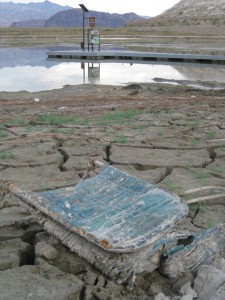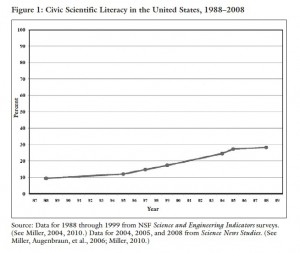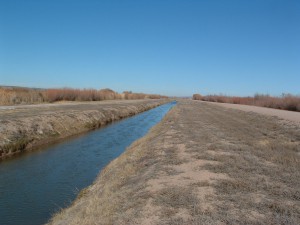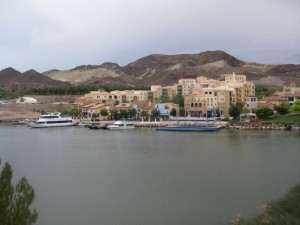A new Stockholm Environmental Institute analysis of water supply and demand in the Southwestern United States suggests we’re screwed.
In the U.S. Southwest – Arizona, California, Nevada, New Mexico, and Utah – there is less rain and snowfall each year than the amount of water used in the region. Today that shortfall is made up for by pumping groundwater, well beyond the sustainable rate. Add the impacts of growing population and incomes, and the Southwest will face a major water crisis in the coming decades.
But you already knew that, right? So what’s new here?

Boulder Bay, Lake Mead, Oct. 2010
I’ll stick my neck out here and argue that despite the paper’s title – “Climate Change and the Southwestern Water Crisis” – the new study’s most important finding may be that the climate change is a relatively minor player in the region’s future water problems, relative to the underlying supply-demand dynamic.
Much of the reporting the last few days has focused on the report’s dire analysis of the scale of the problem (see especially Bryan Walsh and Felicity Barringer’s nice job tying the SEI work in to a related new study on California groundwater depletion). Central to their argument is the fact that we’re using more water each year here in the southwest than nature provides, and we’re closing the supply-demand gap by mining groundwater. That’s the brickbat part of the study. But there are a couple of points that I think are worth drawing out in more detail.
The first is the connection between climate change and the underlying supply-demand problem. The authors, Frank Ackerman and Elizabeth Stanton, first calculate the supply and demand imbalance without climate change, assuming only baseline population and income growth and existing available resources. Given those assumptions, we would use 1.8 billion acre feet of water over the next century in excess of that supplied by nature, a number so staggeringly large, even for people used to thinking about big water numbers, as to be almost meaninglessly beyond comprehension.
Add in climate change (they run a couple of different emissions scenarios), and we need another 300 million to 450 million-plus acre feet. But three quarters of the problem is independent of climate change.
This is a critical point in terms of the political dynamic surrounding climate change and water in the southwest. The west’s water problems are frequently framed as a climate change problem – because of climate change, we have a water problem. Which is true. But the political dynamic surrounding climate change creates huge problems here because of the widespread climate change skepticism afoot in the land. As long as the water problem is framed as a climate change problem, then skepticism of climate change can translate into skepticism of a water problem. (Doug Kenney’s new report on Colorado River governance (pdf) has some great data from a survey of Colorado River Water Users Association that lends support to my intuition on this point.)
I would argue that Ackerman and Stanton have shown that the scale of the problem is, to first order, the same with or without climate change. 1.8 billion or 2.25 billion acre feet shortfall? Whatever, let’s get cracking!
Which is the second useful part of the analysis. OK, we’ve got a huge problem, what can be done about it?
They suggest four potential paths forward:
- increase supply (not likely, they argue, on anything approaching the scale needed)
- more groundwater pumping (what we’ve done to date, but it can’t go on forever, as the resource is finite)
- planned reductions in use
- unplanned reductions in use (eek! the pain!)
Not surprisingly, Ackerman and Stanton suggest “3” as the preferable option. Agriculture currently uses 78 percent of the Southwest’s water, while making up less than 2 percent of the region’s economy. So they argue for an orderly, planned shift from ag to municipal and industrial use:
Farming supports just 1 percent of the Southwest?s economy, and food production manufactures add another 0.8 percent of GDP. Even in California, farming plus food manufactures accounts for only 1.9 percent of state GDP. But agriculture uses 78 percent of all Southwest water, and more water will be required as temperatures grow with climate change. Extensive agricultural adaptation cannot remove all need for conservation and efficiency measures in and around Southwest homes, but it can greatly reduce the need for urban adaptation while providing an important safety net against water shortages and restrictions in dry years.
Which is both important (given the contribution offered by the rigor of their analysis and modeling) and unsurprising. A struggle over the inevitability of ag-urban transfers has long been at the heart of the western dialogue. But this begs the question of how we might accomplish this in a planned vs. unplanned way.
(h/t Keith Kloor for bringing the study to my attention)





